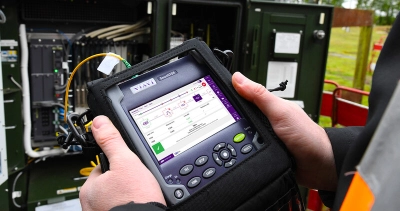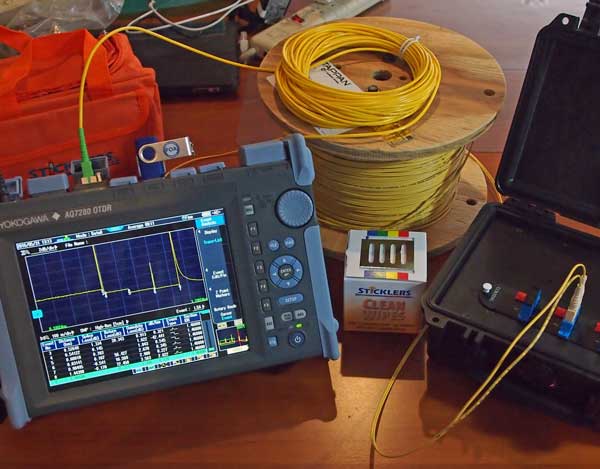Accurate Optical Fibre Diameter Analyser for Detailed Measurements
Wiki Article
Essential Functions to Search For in Optical Fibre Testing Equipment
When assessing optical fiber testing equipment, numerous vital functions warrant cautious factor to consider to ensure optimum efficiency and dependability. Compatibility with existing market criteria boosts performance, while advanced dimension capabilities, consisting of TDR and OTDR testing, deal crucial understandings right into network integrity. Comprehending these attributes will certainly drop light on how to pick the ideal equipment for your details requirements.Precision and Precision
Precision and accuracy are crucial parameters in the analysis of optical fibre screening devices. These 2 features ensure that measurements reflect truth performance of fiber optic systems, which is important for efficient network installment, maintenance, and troubleshooting. Accuracy refers to the nearness of a determined worth to the actual worth, while precision represents the repeatability of measurements under the same problems.When picking optical fibre testing devices, it is necessary to think about tools that offer high precision and precision to reduce errors in information interpretation. Gadgets such as optical time-domain reflectometers (OTDRs) and power meters ought to have calibration mechanisms to guarantee regular performance gradually. Additionally, the specifications provided by suppliers must detail the devices's dimension uncertainty, which straight affects the reliability of examination outcomes.
In addition, the efficiency of optical fiber screening devices can be influenced by environmental aspects, such as temperature and humidity. Consequently, picking tools created to reduce these variables will enhance measurement fidelity. Finally, buying optical fibre testing tools with robust accuracy and accuracy features is basic for preserving optimal network performance and guaranteeing the integrity of fibre optic interactions.

User-Friendly Interface
The performance of optical fibre testing devices is not exclusively established by its accuracy and precision; a straightforward user interface plays a considerable duty in enhancing functional efficiency. A properly designed interface streamlines the interaction in between the specialist and the tools, permitting a more intuitive understanding of complex functions.Trick attributes of an user-friendly interface include clear navigation food selections, rational designs, and easily obtainable controls. These elements allow technicians to perform examinations quickly without extensive training, lowering the possibility of customer mistake - ofda. Additionally, visual signs such as progress bars, signals, and graphical depictions of data can significantly improve the individual experience by giving instant feedback on the testing procedure.
Furthermore, personalized settings can further improve operations by allowing users to change specifications according to specific testing requirements. This adaptability not only saves time but also ensures that the equipment meets diverse application needs.
Incorporating help functions, such as tooltips and extensive handbooks, into the interface can further empower users, advertising self-sufficiency and confidence in operating the equipment. Eventually, an user-friendly user interface is necessary for taking full advantage of the potential of optical fiber screening devices, bring about more effective and reliable testing outcomes.
Transportability and Longevity
Transportability and toughness are important characteristics of optical fibre screening tools, ensuring that it can endure the rigors of various settings while remaining easy to transportation. Specialists often operate in diverse setups, from telecoms centers to remote installments, making it vital that testing devices are light-weight and compact (ofda). Devices made with transportability in mind normally features ergonomic handles and cases that assist in easy movement, thus improving functional performance on-siteDurability is similarly necessary, as optical fiber screening equipment is usually revealed to severe problems, including temperature changes, dampness, and physical influences. Devices constructed with tough products such as strengthened plastics or steel real estates are much better matched for these settings, reducing the danger of damages throughout usage and transportation. In addition, tools with water and dust resistance ratings, such as IP rankings, makes certain trusted efficiency in tough conditions.
Compatibility With Requirements
Ensuring compatibility with sector standards is vital for optical fibre screening tools, as it straight impacts the dependability and legitimacy of test results. Optical fibre networks undergo rigid performance standards developed by different organizations, including the Telecoms Industry Organization (TIA) and the International Electrotechnical Commission (IEC) Testing equipment must adhere to these criteria to make certain that dimensions correspond and similar across various systems and settings.
When selecting optical fiber screening equipment, users must confirm that the gadget satisfies relevant requirements essential to their specific application, such as those pertaining to attenuation, data transfer, and crosstalk. Equipment that is certified with well established requirements not only aids in accomplishing accurate outcomes however also facilitates interoperability amongst devices from different producers.
In addition, compatibility with requirements ensures that the tools can be utilized in governing conformity scenarios, which is essential for tasks in sectors such as telecommunications, aerospace, and armed forces applications. Consequently, buying optical fiber testing devices that aligns with existing industry criteria is an essential element of maintaining quality control and accomplishing optimal network performance.
Advanced Dimension Capabilities
Advanced dimension abilities are a specifying feature of contemporary optical fiber testing devices, enabling extensive evaluation of network performance. These capabilities make certain that specialists can review crucial specifications such as signal loss, dispersion, and transmission capacity, which are important for keeping ideal communication performance.One secret element is the ability to conduct time-domain reflectometry (TDR) and optical time-domain reflectometry (OTDR) tests. These strategies enable individuals to determine mistakes, measure the length of fibres, and identify the area of flaws with amazing precision - ofda. Sophisticated tools often includes the ability to measure optical power degrees, aiding to assess the general health of the network and make sure compliance with the needed specs.
Furthermore, some screening tools supply advanced algorithms for real-time evaluation, enabling quicker medical diagnosis and troubleshooting. This is particularly essential in high-speed networks where downtime can bring about substantial economic losses. With the assimilation of sophisticated software application interfaces, customers can envision data better, promoting informed decision-making. In final thought, purchasing optical fiber testing tools with innovative dimension capabilities is crucial for guaranteeing network reliability and performance in today's requiring telecoms landscape.
Conclusion

Report this wiki page